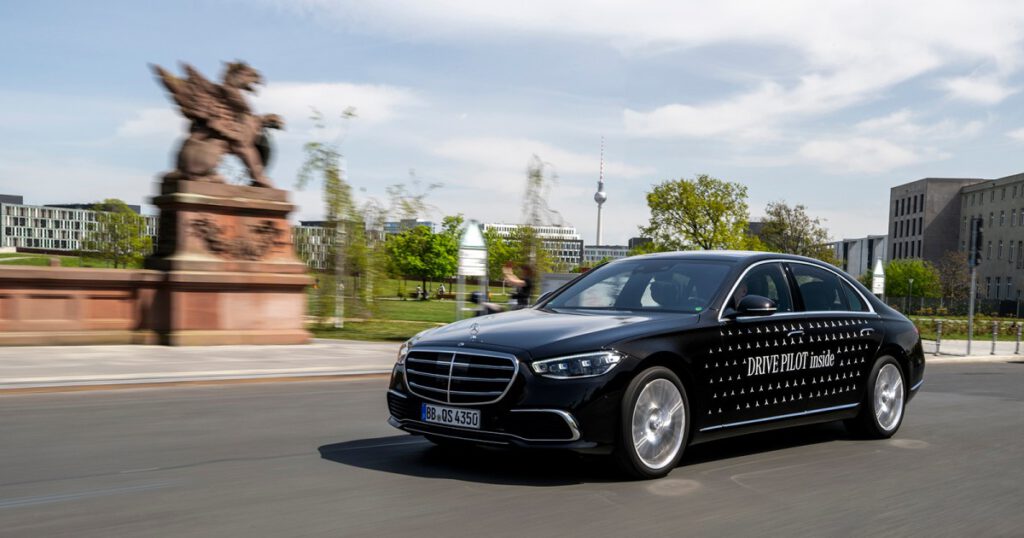Mercedes-Benz has received approval to deploy its Drive Pilot self-driving system in the state of Nevada, making it the first automaker approved for use in the U.S. with a Level 3 system, though others are likely to follow.
Level: Self-driving cars are generally classified according to a standard established by the Society of Automotive Engineers (SAE) in 2014. The standard includes six levels of self-driving, with level 0 cars having no self-driving system and level 5 cars being fully self-driving.
Several companies, including Waymo and Cruise, currently operate ride-hailing services in the United States with vehicles capable of Level 4 self-driving, which means that the car can operate without a driver under certain conditions, such as within designated service areas.
However, the highest level of autonomy currently available to commercial drivers is Level 2. These vehicles can accelerate, brake, and steer automatically in certain scenarios, such as on highways, but the driver must keep their hands on the wheel and their eyes on the road at all times.
When DRIVE PILOT is engaged, the driver does not need to take their eyes off the road.
What’s new? That’s all about to change: The Nevada Department of Transportation has given Mercedes permission to deploy a Level 3 autonomous driving system called Drive Pilot on state highways.
“Mercedes has certified that its technology meets Nevada’s ‘minimal risk condition’ requirements, which require Level 3 or above ‘fully self-driving’ vehicles to be able to stop if there is a system malfunction,” the Nevada DMV told Reuters.
Details: When DRIVE PILOT is engaged, the driver still needs to keep their hands on the wheel, but in certain situations (driving on highways with heavy traffic and vehicles traveling below 37 mph), the driver does not need to take their eyes off the road.
This is the difference between Level 3 and Level 2: the driver still needs to take over from the system when necessary, but they no longer need to pay full attention while the system is engaged.
“This enables customers to save time and focus on specific secondary activities, such as communicating with colleagues via the in-car office, browsing the web or relaxing with a movie,” Mercedes-Benz said.
DRIVE PILOT is equipped with numerous cameras and sensors. Courtesy of Mercedes-Benz
Big spenders: Because DRIVE PILOT requires the installation of specific hardware and can’t be retrofitted to existing cars, people who want to use the service in Nevada will need to buy a new car and be prepared to pay the option fee.
Mercedes-Benz has yet to announce U.S. pricing for Drive Pilot, but it will be available in Germany for 2022 to buyers of S-Class and EQS models for $5,265 and $7,823, respectively. That’s in addition to the $2,559 you’ll pay for the Mercedes Driving Assistance package.
Of course, with the six-figure base prices of these cars, owners might not mind spending an extra $10,000 on a new Mercedes if it includes the ability to shut off the engine during rush-hour commutes.
Level 3-capable systems could be installed in low-cost cars costing around $50,000 by the end of 2023.
What’s next: Mercedes-Benz says it applied for Drive Pilot certification in California at the same time as it applied in Nevada, so approval there could be imminent.
Meanwhile, drivers looking for cheaper self-driving cars may soon have a choice: Kia and Genesis plan to roll out Level 3-capable systems, called Highway Driving Pilot (HDP), on models priced as low as $50,000 by the end of 2023.
These automakers will need to work with each state to get approval for the use of HDP, but Mercedes getting Drive Pilot approval in one state may make it easier for other automakers to level up.
We love hearing from you: If you have any comments about this article or suggestions for future Freethink stories, please email us at tips@freethink.com.

